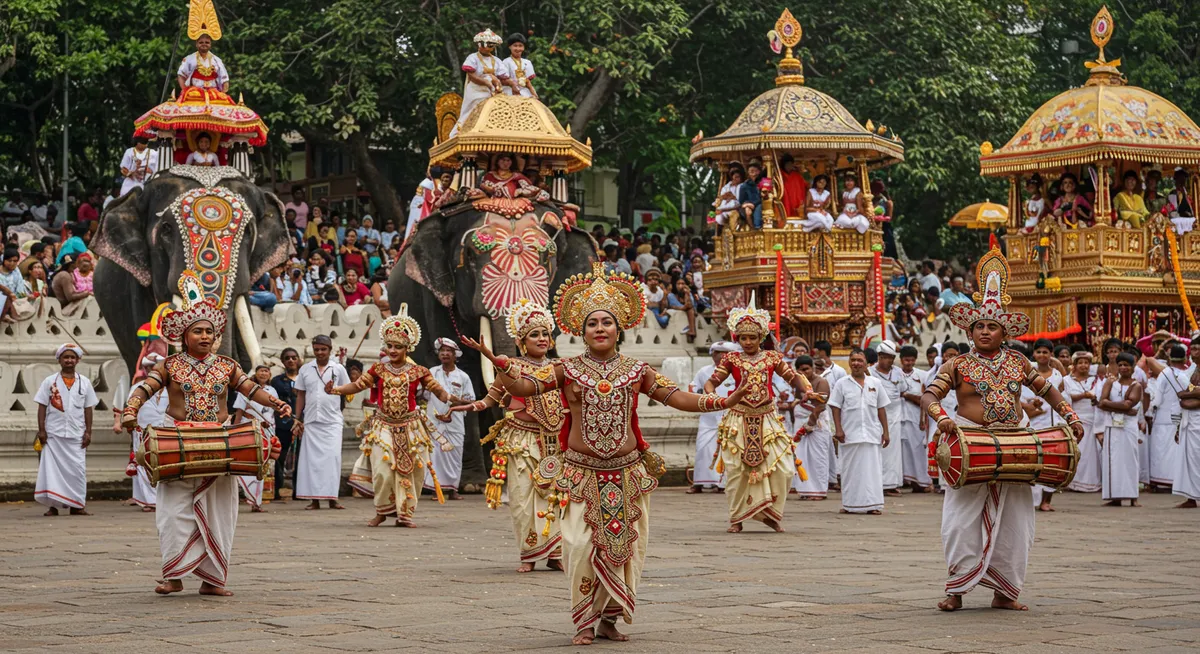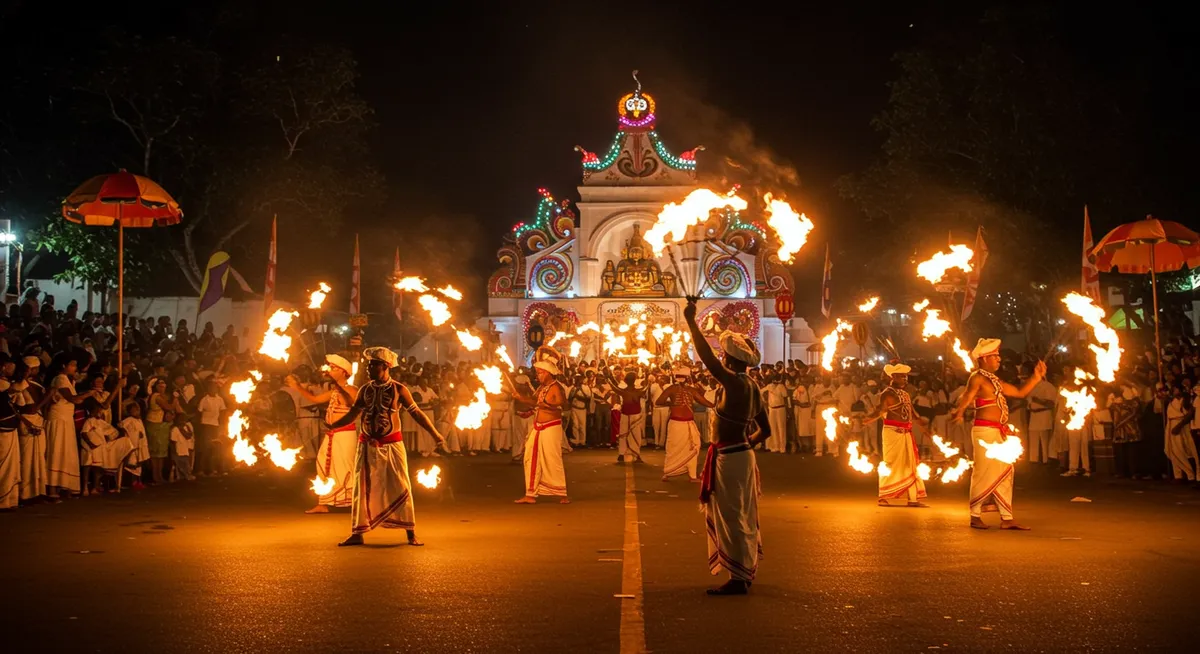Esala Perahera Guide | Sri Lanka's Magnificent Festival of the Sacred Tooth

Esala Perahera: Sri Lanka's Grand Buddhist Procession and Festival of Light
Each summer, the ancient city of Kandy in Sri Lanka's central highlands becomes the stage for one of Asia's most spectacular religious processions. The Esala Perahera (Festival of the Tooth) combines profound Buddhist devotion with breathtaking pageantry as elaborately adorned elephants, traditional dancers, musicians, fire performers, and religious officials march through torch-lit streets to honor the sacred tooth relic of the Buddha. Dating back to the 4th century CE, this extraordinary 10-day festival represents the pinnacle of Sri Lankan cultural expression, drawing hundreds of thousands of devotees and visitors to witness a tradition that has remained largely unchanged for centuries. This guide explores the historical significance, cultural elements, and visitor experience of this magnificent Buddhist celebration.

The Sacred Tooth Relic: The Heart of the Festival
The Esala Perahera revolves around the veneration of Buddha's tooth relic, one of Buddhism's most significant artifacts:
- Historical Significance: According to tradition, the tooth was retrieved from Buddha's funeral pyre in 543 BCE
- Journey to Sri Lanka: The relic arrived in Sri Lanka in the 4th century CE, hidden in the hair of a princess
- Royal Connection: Possession of the tooth traditionally legitimized the right to rule Sri Lanka
- The Temple of the Sacred Tooth (Sri Dalada Maligawa): The golden-roofed temple in Kandy where the relic is housed
- Modern Significance: The relic represents Buddha's living presence to devotees
Historical Origins of the Perahera
The festival combines multiple historical and cultural traditions:
- Ancient Water Rituals: Originally began as ceremonies to request rain from gods during periods of drought
- Buddhist Integration: Merged with tooth relic veneration when Kandy became the last Sinhalese kingdom
- Royal Patronage: Traditionally sponsored by Sri Lankan kings to demonstrate their Buddhist legitimacy
- Cultural Preservation: Maintained even during colonial periods as a symbol of Sinhalese cultural identity
- Modern Continuation: Now administered by Buddhist authorities with government support
Festival Structure and Schedule
Esala Perahera unfolds over ten nights with increasing grandeur:
Kap Situveema (Tree Planting Ceremony)
The festival begins with a ceremonial planting:
- Sacred Trees: Sanctified saplings planted in the grounds of the four devales (shrines to guardian deities)
- Ritual Significance: Symbolizes prosperity and blessings for the festival
- Ancient Origins: Traces back to pre-Buddhist fertility rituals
- Private Ceremonies: Conducted primarily by priests with limited public attendance
Kumbal Perahera (First Five Nights)
The initial processions grow gradually more elaborate:
- Growing Scale: Each night adds more dancers, elephants, and ceremonial elements
- Devale Processions: Initial focus on the four guardian deities of Sri Lanka
- Ritual Purification: Ceremonies to cleanse the route and participants
- Simpler Presentation: Less crowded opportunity to view traditional elements

Randoli Perahera (Final Five Nights)
The main processions feature maximum grandeur:
- Tooth Relic Procession: A replica of the sacred tooth relic casket is carried on the majestic Maligawa Tusker
- Full Ceremonial Display: Hundreds of elephants, dancers, musicians, and officials participate
- Randoli: Palanquins representing queens join the procession, giving this phase its name
- Night Illumination: Torch bearers, oil lamps, and modern lighting create a spectacular atmosphere
- Massive Crowds: The final night attracts the largest attendance as the most auspicious viewing
Diya Kepeema (Water Cutting Ceremony)
The culmination occurs through water rituals:
- Procession to the Mahaweli River: Priests and officials move to the river at dawn after the final night
- Sacred Waters: A sword cuts the river water to symbolize separating pure from impure
- Blessing Distribution: The sanctified water is preserved for the coming year's prosperity
- Day Perahera: A final daytime procession returns to the temple
Key Elements of the Perahera
The procession showcases Sri Lanka's rich cultural and religious traditions:
The Elephants
Elephant participation represents a central spectacle of the festival:
- The Maligawa Tusker: The lead elephant carrying the tooth relic casket, adorned with gold-embroidered garments
- Ceremonial Adornment: Elephants dressed in elaborate velvet costumes with intricate embroidery and lights
- Temple Elephants: Each major temple contributes elephants representing their deities
- Cultural Significance: Elephants symbolize strength, wisdom, and the royal heritage of the festival
Traditional Performers
The procession features several distinctive performance traditions:
- Kandyan Dancers: Classical dancers performing traditions unique to the central highlands
- Whip Crackers (Kasa Netum): Opening the procession with loud whip cracks to dispel evil spirits
- Fire Dancers (Ginisila): Performers twirling fire pots and breathing flames
- Flag Bearers: Carriers of Buddhist symbols and historical flags of the Kandyan kingdom
- Ritual Musicians: Drummers, flutists, and conch blowers performing ancient ceremonial music
Devale Processions
The four guardian deities play a significant role in the festival:
- Natha Devale: Dedicated to Natha, a future Buddha in Buddhist cosmology
- Vishnu Devale: Honoring the Hindu deity Vishnu, considered a guardian of Buddhism in Sri Lanka
- Kataragama Devale: Dedicated to the six-headed war deity popular throughout Sri Lanka
- Pattini Devale: Honoring the goddess of fertility and health

Spiritual and Cultural Significance
Beyond its visual spectacle, the Perahera holds profound meaning for Sri Lankan Buddhists:
- Relic Veneration: Proximity to the tooth relic during Perahera is considered highly meritorious
- Vow Fulfillment: Many participants join the procession to fulfill religious vows
- Cultural Identity: The festival represents a living connection to Sri Lanka's ancient heritage
- Religious Syncretism: Demonstrates the integration of Buddhist, Hindu, and indigenous beliefs
- Annual Renewal: The ceremonies are believed to ensure prosperity for the coming year
Experiencing the Perahera as a Visitor
For travelers, witnessing the Esala Perahera offers a profound cultural experience:
Practical Arrangements
Planning is essential for a successful Perahera experience:
- Festival Timing: Typically falls in July-August during the full moon (Esala) month
- Advanced Booking: Accommodation in Kandy should be reserved 6-12 months in advance
- Viewing Options: Ticketed seats on platforms, standing room along routes, or hotel balconies
- Arrival Strategy: Reach viewing areas at least 3-4 hours before the procession begins
- Multiple Nights: Consider attending both earlier (less crowded) and later (more elaborate) nights
Cultural Etiquette
Respectful participation enhances the experience:
- Modest Dress: Cover shoulders and knees as appropriate for a religious event
- Temple Visits: Remove shoes and cover heads when entering the Temple of the Sacred Tooth
- Photography Considerations: Flash photography may be restricted near elephants and performers
- Religious Respect: Maintain appropriate behavior during religious elements of the procession
Beyond the Procession
The Perahera period offers additional cultural experiences:
- Temple Visits: The Sacred Tooth Temple is open to visitors throughout the festival
- Traditional Arts: Special exhibitions of Kandyan crafts and performing arts
- Festival Foods: Street vendors offer regional specialties during the celebration
- Kandy Cultural Attractions: The city's botanical gardens, museums, and historic sites
Conservation and Ethical Considerations
Modern awareness has brought attention to elephant welfare during the festival:
- Traditional Practices: The historical role of elephants in Buddhist ceremonies spans centuries
- Evolving Standards: Improved care protocols for temple elephants participating in the procession
- Reduced Duration: Limiting the time elephants spend in processions
- Welfare Monitoring: Veterinary supervision throughout the festival period
- Cultural Balance: Authorities work to maintain traditions while addressing welfare concerns
Planning your Esala Perahera visit?
The festival dates change annually based on the lunar calendar, typically falling in July or August. Check the exact dates with Sri Lankan tourism authorities when planning your trip.
For the most comprehensive experience, plan to spend at least three nights in Kandy, allowing you to witness both the developing Kumbal Perahera and the magnificent Randoli Perahera processions.
Explore Related Asian Religious Festivals
If you're fascinated by Esala Perahera, consider experiencing these other remarkable religious processions across Asia:
Thaipusam
Tamil Hindu festival featuring pierced devotees carrying elaborate kavadi structures.
Vesak
Buddhist celebration of Buddha's birth, enlightenment, and passing with lantern processions and rituals.
Navaratri
Nine-night Hindu festival with elaborate goddess processions and ceremonial dances.
Phuket Vegetarian Festival
Taoist processions featuring extreme facial piercings and spiritual possession.
Waisak at Borobudur
Lantern procession around the world's largest Buddhist temple in Indonesia.
Gion Matsuri
Japan's month-long festival featuring enormous decorated floats paraded through Kyoto.
Religious processions across Asia combine devotional fervor with cultural expression. While Esala Perahera centers on Buddha's tooth relic, Vesak celebrations demonstrate devotional sacrifice, and Gion Matsuri showcases Japanese artistic traditions. Each procession reveals unique expressions of faith through communal celebration.